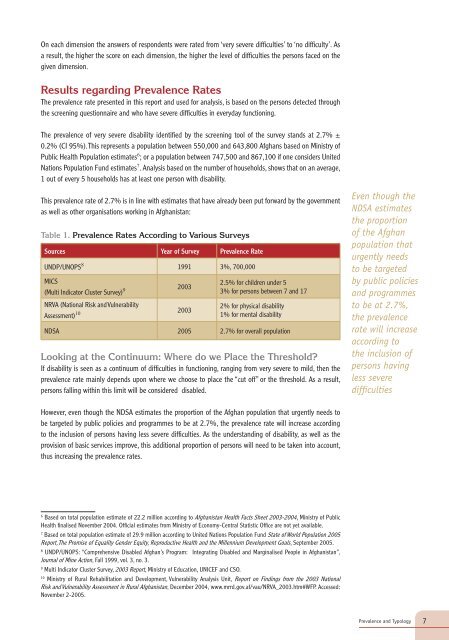Handicap International experience in Afghanistan - CBM
Handicap International experience in Afghanistan - CBM
Handicap International experience in Afghanistan - CBM
- No tags were found...
You also want an ePaper? Increase the reach of your titles
YUMPU automatically turns print PDFs into web optimized ePapers that Google loves.
On each dimension the answers of respondents were rated from ‘very severe difficulties’ to ‘no difficulty’. Asa result, the higher the score on each dimension, the higher the level of difficulties the persons faced on thegiven dimension.Results regard<strong>in</strong>g Prevalence RatesThe prevalence rate presented <strong>in</strong> this report and used for analysis, is based on the persons detected throughthe screen<strong>in</strong>g questionnaire and who have severe difficulties <strong>in</strong> everyday function<strong>in</strong>g.The prevalence of very severe disability identified by the screen<strong>in</strong>g tool of the survey stands at 2.7% ±0.2% (CI 95%). This represents a population between 550,000 and 643,800 Afghans based on M<strong>in</strong>istry ofPublic Health Population estimates 6 ; or a population between 747,500 and 867,100 if one considers UnitedNations Population Fund estimates 7 . Analysis based on the number of households, shows that on an average,1 out of every 5 households has at least one person with disability.This prevalence rate of 2.7% is <strong>in</strong> l<strong>in</strong>e with estimates that have already been put forward by the governmentas well as other organisations work<strong>in</strong>g <strong>in</strong> <strong>Afghanistan</strong>:Table 1. Prevalence Rates Accord<strong>in</strong>g to Various SurveysSources Year of Survey Prevalence RateUNDP/UNOPS 8 1991 3%, 700,000MICS(Multi Indicator Cluster Survey) 9 2003NRVA (National Risk and VulnerabilityAssessment) 10 20032.5% for children under 53% for persons between 7 and 172% for physical disability1% for mental disabilityNDSA 2005 2.7% for overall populationLook<strong>in</strong>g at the Cont<strong>in</strong>uum: Where do we Place the Threshold?If disability is seen as a cont<strong>in</strong>uum of difficulties <strong>in</strong> function<strong>in</strong>g, rang<strong>in</strong>g from very severe to mild, then theprevalence rate ma<strong>in</strong>ly depends upon where we choose to place the “cut off” or the threshold. As a result,persons fall<strong>in</strong>g with<strong>in</strong> this limit will be considered disabled.Even though theNDSA estimatesthe proportionof the Afghanpopulation thaturgently needsto be targetedby public policiesand programmesto be at 2.7%,the prevalencerate will <strong>in</strong>creaseaccord<strong>in</strong>g tothe <strong>in</strong>clusion ofpersons hav<strong>in</strong>gless severedifficultiesHowever, even though the NDSA estimates the proportion of the Afghan population that urgently needs tobe targeted by public policies and programmes to be at 2.7%, the prevalence rate will <strong>in</strong>crease accord<strong>in</strong>gto the <strong>in</strong>clusion of persons hav<strong>in</strong>g less severe difficulties. As the understand<strong>in</strong>g of disability, as well as theprovision of basic services improve, this additional proportion of persons will need to be taken <strong>in</strong>to account,thus <strong>in</strong>creas<strong>in</strong>g the prevalence rates.6Based on total population estimate of 22.2 million accord<strong>in</strong>g to <strong>Afghanistan</strong> Health Facts Sheet 2003-2004, M<strong>in</strong>istry of PublicHealth f<strong>in</strong>alised November 2004. Official estimates from M<strong>in</strong>istry of Economy-Central Statistic Office are not yet available.7Based on total population estimate of 29.9 million accord<strong>in</strong>g to United Nations Population Fund State of World Population 2005Report, The Promise of Equality Gender Equity, Reproductive Health and the Millennium Development Goals, September 2005.8UNDP/UNOPS: “Comprehensive Disabled Afghan’s Program: Integrat<strong>in</strong>g Disabled and Marg<strong>in</strong>alised People <strong>in</strong> <strong>Afghanistan</strong>”,Journal of M<strong>in</strong>e Action, Fall 1999, vol. 3, no. 3.9Multi Indicator Cluster Survey, 2003 Report, M<strong>in</strong>istry of Education, UNICEF and CSO.10M<strong>in</strong>istry of Rural Rehabilitation and Development, Vulnerability Analysis Unit, Report on F<strong>in</strong>d<strong>in</strong>gs from the 2003 NationalRisk and Vulnerability Assessment <strong>in</strong> Rural <strong>Afghanistan</strong>, December 2004, www.mrrd.gov.af/vau/NRVA_2003.htm#WFP. Accessed:November 2-2005.Prevalence and Typology7
















